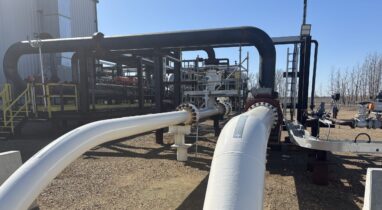This is Clean Prosperity’s submission in response to the federal government’s discussion document “Options to cap and cut oil and gas sector greenhouse gas emissions to achieve 2030 goals and net-zero by 2050”.
February 2024 update: Clean Prosperity delivered a new submission in response to the federal government’s request for input on its Regulatory Framework for an Oil and Gas Sector Greenhouse Gas Emissions Cap.
December 2024 update: Clean Prosperity submitted a notice of objection to the federal government on the proposed Oil and Gas Sector Greenhouse Gas Emissions Cap Regulations.
Introduction
The Canadian federal government has proposed to cap and cut emissions from the oil and gas sector with two possible policy measures — a new cap-and-trade system (option one), or a higher carbon price for oil and gas (option two).
In this submission we recommend an alternate approach to the government’s second option. We recommend that the government use the existing federal and provincial output-based pricing systems to achieve its emissions-reduction objectives.
Our recommendations are about effectively achieving the government’s objective of reducing emissions from the oil and gas sector using targeted policies — but they aren’t an endorsement of this objective. Clean Prosperity advocates for policies that reduce emissions across the entire Canadian economy, rather than targeting particular sectors.
If the government implements new policies for the oil and gas sector, we emphasize the importance of achieving a reduction in emissions, and not reductions in production that aren’t driven by declines in global demand — as the government stated in the 2030 Emissions Reduction Plan (ERP).
Recommendations
We recommend four important measures that can help the government achieve its goals.
1. Dynamically adjust the minimum stringency criteria of the federal benchmark for carbon pollution pricing systems in Canada.
Stringency should be adjusted with the goal of maintaining an emissions reduction trajectory — both in the oil and gas sector, and across Canadian industry — that is consistent with the federal government’s 2030 ERP.
The federal government should determine the optimal schedule for stringency adjustment in order to achieve the ERP targets, in consultation with the provinces and based on sound energy-economy modelling.
The stringency rate in any year could be adjusted based on an “adaptive” approach that considers current market conditions and prior-year emissions reductions. This approach is described in Clean Prosperity’s recent report on the Alberta TIER system.
2. Guarantee Canada’s carbon-pricing system using mechanisms like contracts for difference and policy-contingent loans.
Offering a guarantee on the carbon price — as the government committed to exploring in the 2030 ERP — will help to reduce uncertainty about the future direction of Canada’s cornerstone climate policy. This will give firms the confidence to invest now in big decarbonization projects, both in the oil and gas sector and across the economy.
The federal government could offer contracts for difference or policy-contingent loans designed to insure the trajectory of the federal carbon price, the future value of carbon credits in output-based pricing systems — or both.
Quickly deploying mechanisms to increase carbon-pricing certainty will do more to accelerate final investment decisions in big decarbonization projects than new pricing or cap-and-trade systems, both of which could be vulnerable to legal challenges that might lead businesses to take a “wait and see” approach.
3. Limit the generation of offset credits within output-based pricing systems to atmospheric carbon dioxide removal (CDR), and allow them to be used without limit.
Offset credits should only be generated by CDR projects that guarantee the permanent removal of carbon emissions — i.e., for a minimum of 1000 years. This includes methods such as direct air capture with geologic sequestration. It shouldn’t be possible to generate offsets with methods that are difficult to measure, aren’t necessarily additive, and that risk re-releasing captured carbon into the atmosphere.
If only high-quality offsets are available, we also recommend that oil and gas facilities — and all industrial emitters — have unlimited access to these emission-reduction opportunities, including the trading of carbon credits between oil and gas and other industrial sectors. We do not believe it is prudent to limit offsets as described in the government’s discussion document. Incentivizing emissions reductions serves Canada’s 2030 ERP goals, regardless of where in the economy those reductions occur.
4. Protect the competitiveness of emissions-intensive, trade-exposed (EITE) industries — including the oil and gas sector.
If carbon pricing is to remain “the cornerstone of Canada’s approach to climate action,” then we urgently need to reckon with its potential impacts on the competitiveness of Canadian industry, and address the risk of carbon leakage.
Should Canada’s carbon price and the stringency of industrial carbon-pricing systems increase at a rate that is consistent with the emissions-reduction goals in the 2030 ERP, EITE industries will increasingly be competing on an uneven playing field against firms from jurisdictions with less ambitious climate policies — or more generous subsidies. The recent passage of the US Inflation Reduction Act, containing hundreds of billions of dollars in decarbonization incentives, creates an even greater imperative to address Canadian industrial competitiveness.
One mechanism that can effectively address this problem is a border carbon adjustment — tariffs on the carbon content of imports, as well as the possibility of rebates on carbon charges for Canadian exporters.
Advantages of optimizing existing policies
Why does it make more sense to optimize the federal government’s existing carbon-pricing policies in the ways we describe above, in order to accelerate emissions reductions both in the oil and gas sector and across the Canadian economy?
1. It’s faster and more efficient to optimize the policies we already have than to introduce new ones.
We have just over seven years to achieve the ambitious emissions reductions laid out in the 2030 ERP. After years of shifting federal and provincial climate policies, industry and investors urgently need clarity and certainty in order to make the big investments in decarbonization that are required to achieve our 2030 targets. What they don’t need are expectations to reconcile their operations with new climate policies, and obligations to navigate new administrative systems.
We don’t have time to develop and implement new systems to help achieve the 2030 targets — especially when considering that both of the federal government’s proposed options could face years of legal challenges. It also doesn’t make sense to implement new systems when the existing ones are fit for purpose.
2. Increasing the stringency of our existing carbon-pricing systems can reduce emissions from oil and gas — and across the economy.
The 2030 ERP is clear: we need to reduce emissions from all sectors of Canadian industry in order to achieve our climate targets — not just from the oil and gas sector. This is the purpose, and the power, of an economy-wide carbon price: to reduce all our emissions in the most cost-effective manner possible. We should continue to treat industrial emissions-reduction holistically, as the industrial carbon-pricing system was designed to do, and optimize the entire system to best achieve the ERP targets.
3. Optimizing the tools we already have would minimize disruptions for provincial industrial carbon-pricing systems.
Provinces have already designed industrial carbon-pricing systems according to the unique characteristics of their economies, industries, and emissions-reduction strategies. Rather than upending these systems with a completely new set of federal policies targeted at the oil and gas sector, we should seek to minimize the disruption to provincial systems by making only the minimal adjustments that are needed to give ourselves the best chance of meeting the targets laid out in the 2030 ERP.
Further, there is already a provision in the federal pricing benchmark effectively requiring that demand for credits exceed supply within industrial carbon pricing systems. This existing provision can be the basis for adjustments to system stringency.
4. Working with the existing system avoids the risk of negative policy interactions.
Adding new systems risks disrupting the dynamics of existing climate change policies and hindering progress towards Canada’s climate targets. For example, both a cap-and-trade system and a special carbon-pricing system for the oil and gas sector jeopardize the efficient operation and decarbonization incentives of carbon-credit markets.
Additional considerations
1. Our recommendations require adjusting commitments made to the provinces — but so do the other options.
The federal government is in the late stages of approving provincial industrial carbon-pricing systems for the 2023-2027 period based on a set of criteria laid out in the updated federal benchmark. Understandably, the government is reluctant to apply new conditions to negotiations with the provinces, such as the flexibility to adjust carbon-pricing stringency that we recommend.
But the government’s proposed policy options would also impact the agreements made with provinces on carbon pricing. A cap-and-trade model would drastically affect the value of credits within the industrial pricing systems, with potentially negative consequences for industrial facilities outside the oil and gas sector. The government’s proposal to implement a higher carbon price for oil and gas would require creating a separate sub-system within the existing output-based pricing systems. The discussion paper indicates that those changes wouldn’t be made until 2027, but that would clearly be too late to incentivize the emissions reductions needed to achieve the 2030 ERP targets.
2. Cap-and-trade systems present important challenges.
The government’s proposal to set up a new cap-and-trade system for emissions from oil and gas, in addition to existing federal and provincial regulations that apply to the sector, presents challenges for achieving the 2030 ERP emissions-reduction targets.
First, a cap-and-trade system could take a long time to set up, require complex negotiations with the provinces, and add new administrative requirements for industry and investors that could delay the deployment of decarbonization initiatives.
A novel cap-and-trade system imposed by the federal government might invite legal challenges that could stall its implementation. It also presents the risk of unfavourable interactions with existing emissions-reduction mechanisms like carbon-credit markets.
Finally, it’s not clear that a cap-and-trade system would necessarily deliver a level of emissions-reduction certainty that would make it preferable to existing output-based pricing systems. Unless the government is willing to let the price of emission allowances rise unchecked, the cap must remain flexible. No existing cap-and-trade system in a major economy applies an inflexible cap to the price of allowances, because of the economic risks this would present.
While the government has stated that it would be able to address price risk by holding some emissions permits in reserve, we have concerns about whether this measure would be sufficient given the scale of emissions reductions required and the short window of time — less than seven years — in which to achieve them.
3. Increase stringency to increase the marginal price of emissions.
In the discussion document, the government argues that increasing the price of carbon is a more effective way to incentivize emissions reductions than increasing the stringency of output-based carbon pricing systems.
We disagree. Increasing stringency increases the effective marginal price of emissions because it increases demand for credits and buffers against the risk that credit markets become oversupplied. Under the current system design, credit values are a bigger driver of decarbonization than the carbon price itself. If credit values are low — due to insufficient stringency — an increase in price will not impact the marginal value of reductions below the emissions-intensity threshold.
Example: An oil refinery is considering a carbon capture and storage (CCS) project that will sequester one million tonnes of CO2 per year. The CCS project will help the refinery avoid paying the carbon price on 200,000 tonnes of emissions, and it will sell credits earned on the other 800,000 tonnes. If there is an oversupply of credits in this market, the credits will sell below the carbon price. That will drive the marginal value of the project below what it would have been had the stringency of industrial carbon pricing been higher, supporting higher carbon-credit prices.
Increasing stringency is possible within the existing design of industrial carbon-pricing systems, and would also incentivize reductions in other industries.
Conclusion
In our view, the fastest and most efficient way to achieve the 2030 ERP’s goals of reducing emissions from the oil and gas sector — and from Canadian industry as a whole — is to optimize our existing carbon-pricing systems, rather than creating new ones.
Dynamically adjusting the minimum stringency criteria of the federal benchmark, in order to drive emissions reductions towards the 2030 ERP goals, would be a way of delivering cuts without adding new systems that could actually hinder our progress towards decarbonization. Industry and investors don’t need new systems to master; they need a stable, predictable climate policy environment in order to start building out the decarbonization projects that we urgently need.
Guaranteeing existing policies through mechanisms like contracts for difference and policy-contingent loans tied to the carbon-price trajectory, or the future value of carbon credits, can also help accelerate this process. Limiting the generation of offsets to projects that are verifiably and permanently removing carbon from the atmosphere will strengthen the carbon-price signal while also meaningfully reducing emissions.
At the same time we need protections for Canada’s EITE industries, such as border carbon adjustments, if we’re going to continue relying on carbon pricing as the cornerstone of climate action. Time is short; let’s make the best use of the tools we already have in order to reach our emissions-reduction goals for Canada’s oil and gas sector, and for Canadian industry as a whole.




